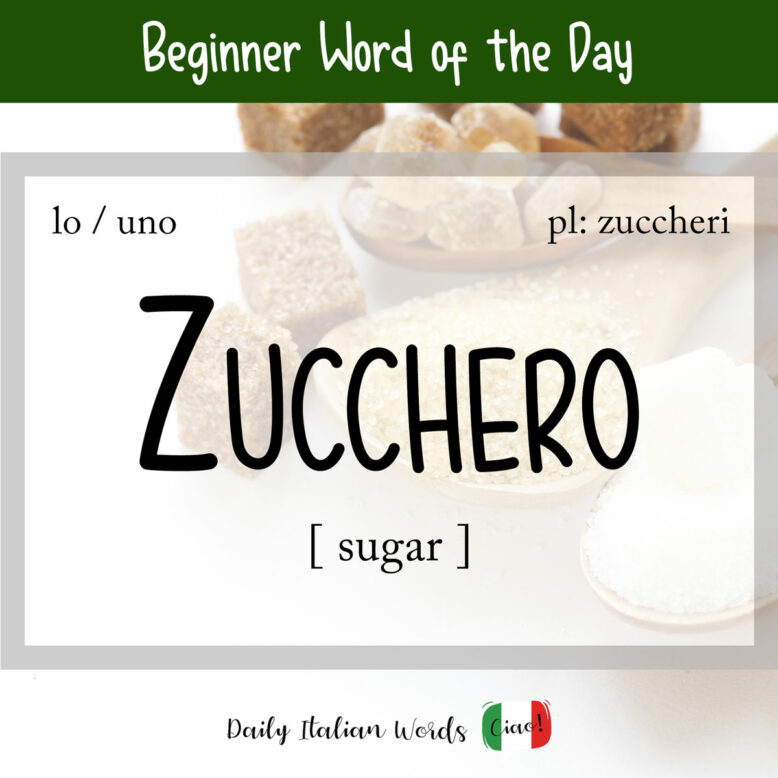The word for sugar in Italian is zucchero (masculine, plural: zuccheri). It likely entered the language via medieval Latin from the Arabic word sukkar.

Most people are familiar with the standard zucchero semolato (white sugar) or zucchero bruno (brown sugar) but there are also many other kinds of sugar in existence including:
- zucchero integrale = whole sugar
- zucchero di canna = cane sugar
- zucchero di malto = malt sugar
- zucchero di palma = palm sugar
- zucchero d’acero = maple sugar
- zucchero a velo = icing sugar, powered sugar
- zucchero extrafine = caster sugar
- zucchero filato = cotton candy
Ho usato lo zucchero bruno per fare questa torta.
I used brown sugar to make this cake.

To add sugar in Italian can be expressed using the verb aggiungere (to add) + zucchero (sugar) or the related verb zuccherare.
Ricordati di aggiungere un cucchiaio di zucchero nel caffè di papà.
Remember to add one teaspoon of sugar to dad’s coffee.
Sucrose (saccarosio), which is the scientific name for table sugar, consists of one glucose (glucosio) and one fructose (fruttosio) molecule. These three types of sugar are found naturally in fruits, vegetables, dairy products, grains and are added to processed foods.
When talking about blood sugar, the plural zuccheri is often used rather than the singular. The expression calo di zuccheri (low blood sugar), for example, is simply a more informal way of saying ipoglicemia (hypoglycaemia).
Ieri ho avuto un calo di zuccheri.
Yesterday I had low blood sugar.
Like many food-related words in Italian, zucchero also has a figurative meaning. Instead of saying that an item of food or drink is molto dolce (very sweet), you can describe it using the word zucchero (e.g. Questa mela è uno zucchero! = This apple is very sweet!). By extension, it can also describe a person or thing that is lovable (e.g. Quella ragazza è uno zucchero. = That girl is a sweetie.).
Carta da zucchero (construction paper or sugar paper) is a kind of coloured paper with a rough surface that children use when they make crafts and art projects.
Did you know that…?
Carta da zucchero is also the name given to the colour baby blue. It is called as such because until the mid 20th century, sugar was sold by weight and wrapped in a paper of this characteristic blue colour so as to mask any stains or discolourations due to the artisan paper-making process.
Zucchero – The Artist
Anyone who loves Italian music will certainly be familiar with Adelmo Fornaciari, an Italian singer-songwriter and musician more commonly known by his stage name Zucchero Fornaciari or simply Zucchero. The reason he chose the name is because his elementary school teacher used to call him Zucchero. In his career, he has sold over 60 million records worldwide and collaborated with famous artists such as Eric Clapton, Jeff Beck, Brian May, Sting, Bono and Pavarotti.
One of Zucchero’s most beautiful songs, which was also successful internationally, is Il Volo (The Flight), known as My Love in English and El Vuelo in Spanish. You can listen to the Italian version below!
Heather Broster is a graduate with honours in linguistics from the University of Western Ontario. She is an aspiring polyglot, proficient in English and Italian, as well as Japanese, Welsh, and French to varying degrees of fluency. Originally from Toronto, Heather has resided in various countries, notably Italy for a period of six years. Her primary focus lies in the fields of language acquisition, education, and bilingual instruction.


